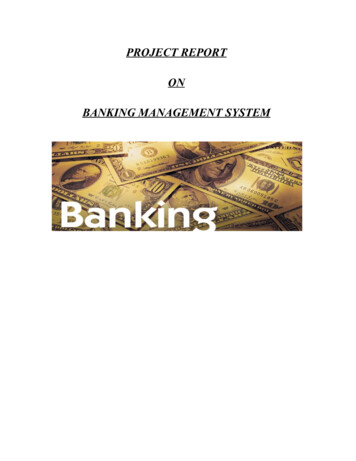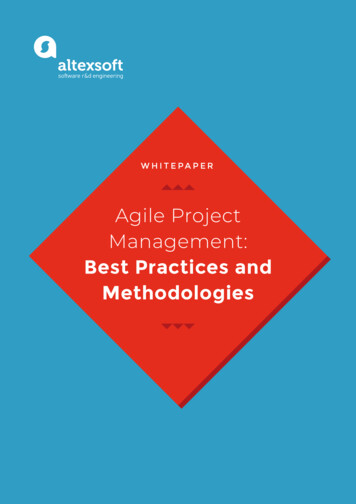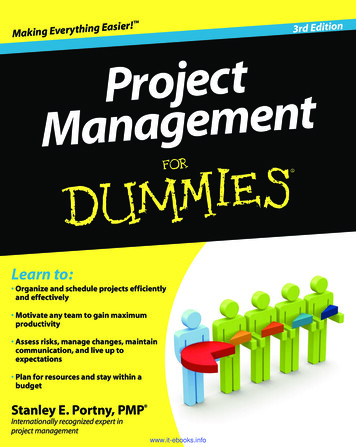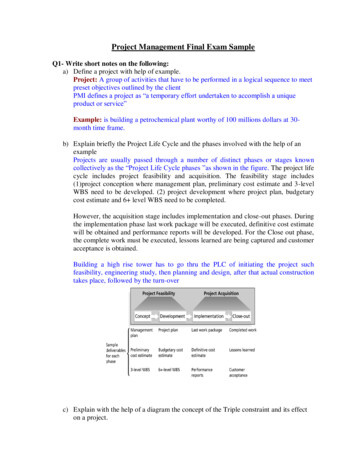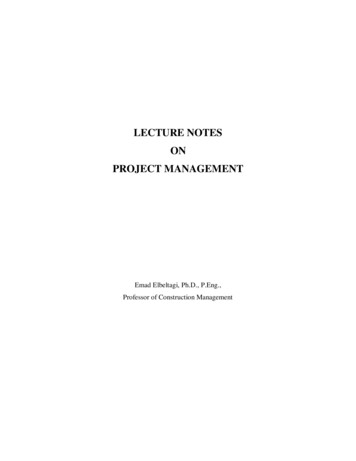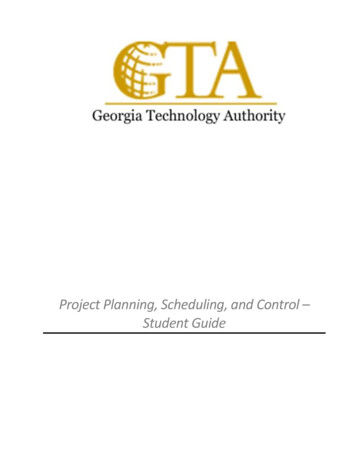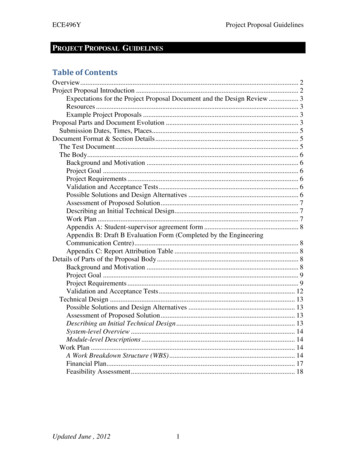
Transcription
Final Report on Project Management Skillsof the University of California Libraries’ StaffJuly, 2010from theProject Management Skills Task ForceMembers:Joan Starr, CDL, ChairMary Linn Bergstrom, UC San DiegoAdrian Petrisor, UC Irvine
Final Report on Project Management Skills1. Executive SummaryThis report represents the culmination of the work of the Project Management Skills Task Force (PMSTF) andis primarily composed of a set of recommendations.The PMSTF recommends the creation of a new Project Management Common Interest Group (PMCIG),reporting to SOPAG, with responsibilities tied to a number of the other recommendations.The other key recommendations are: Establish an annual inventory that identifies people in the UC Libraries with project managementskills. Access to the names should be restricted and made available to SOPAG, as needed. Use the skill inventory to select project managers for systemwide projects when appropriate.Determine appropriateness based on a known set of criteria. A recommended set of criteria isprovided. Focus and fund skill building resources on the skills and techniques that are most critical andweakest (based on the survey, initially, and revised annually.) Pursue a blended approach to project management training, including solutions such as mentoring,peer-to-peer, and on-site, and web-based training. Assign to the PMCIG the tasks of creating a project management glossary and central repository forproject management resources, creating and maintaining standard templates for use in systemwideprojects, and creating and promoting a project management community of interest. Make several changes to the way that systemwide projects are charged by SOPAG and the ACGs: Include an explicit problem statement and success criteria; Specify the scope and resources, but allow the timeframe or scope to be negotiated with theconstituted team within a month of the first team meeting. Require that the project manager (and team) conduct a risk assessment as one of the firsttasks and come back to the charging entity with results for adjustments to resources or otherelements of the charge. Require that project manager utilize the PMCIG project definition template as an analysistool. When a project manager is assigned to a systemwide project, require a role discussionbetween the project manager and the team manager and as one of the first tasks for the twoleaders.The Appendices of this report provide a list of the key Project Management Skills and Techniques (AppendixA), a draft charge for the Project Management Common Interest Group (Appendix B), and the results of thesurvey of UC library staff members conducted in January 2010 (Appendix C).Project Management Skills, Final ReportPage 2
2. IntroductionThe work of the Project Management (PM) Skills Task Force began in August, 2009. We started with a carefulstudy of our Charge, and two references: the Background preceding the charge and the UC CollaborativeDigital Projects Principles, Roles, and Responsibilities document that had been prepared in 2007, followingthe VDX Implementation Project.We then created a simple work program which included the following steps: Identifying a preliminary list of key project management skills; Developing and implementing a survey of campus library staff members about their level ofcompetence at those skills; Analyzing the results of the survey, and using that information to reassess the project managementskills list and to develop preliminary recommendations; Consulting with the All Campus Groups (ACGs) and SOPAG about our revised skills list and about ourpreliminary recommendations; and Developing our final recommendations.Our final recommendations are the main body of this report, and, as mentioned above, they are based uponinput from the ACGs and SOPAG as well as analysis of the survey responses. We have also drawn upon ourown individual experiences as project managers and as UC library staff members to inform our thinking.Additionally, we were able to spend a day together holding in-depth discussions about theserecommendations.As a final note, we got additional input for Recommendation C (Training) from a special group of people:those survey respondents who indicated they had experience with training that made a difference, and alsowho told us we could re-contact them for follow-up.Project Management Skills, Final ReportPage 3
3. RecommendationsOverarching recommendation:Establish a Project Management Common Interest Group (PMCIG), reporting directly to SOPAG. Thejustification for reporting directly to SOPAG and not to a specific All Campus Group (ACG) is twofold.First, the scope of systemwide projects is beyond that of any one of the ACGs, and it may limit the impactof the PMCIG’s work on systemwide projects if it is tied to a single ACG. Second, all ACGs expressed aninterest in the outcome of this Task Force’s work. An ongoing open information exchange with the PMCIGwill be much easier if it is seen as neutral rather than associated with a particular ACG.The PMCIG will have one representative from each campus, plus one CDL representative. Members willbe selected by the SOPAG representatives. The PMCIG will include a liaison member from SOPAG. TheChair is selected by the membership and will serve for 2 years.A draft charge for CIG is available in Appendix A.A. Continued identification of individuals with PM skillsObservation. While the survey conducted by the PM Task Force collected information about UC Librariesstaff with project management skills, survey participants (and SOPAG and LTAG representatives whoprovided the respondents’ names) were assured of confidentiality1. Therefore, there is no current,accurate inventory of people across the UC Libraries system with project management skills. Such a list isnecessary in order to effectively review, select, and assign people with the appropriate skills, techniquesand experience to projects as they arise.Recommendation:Assign to the PMCIG the task of establishing an annual inventory that identifies people in the UC Librarieswith PM skills and techniques. Use the existing lists of suggested names submitted by LTAG and SOPAG representatives for theJanuary 2010 PM Skills Survey as the starting point. Re-contact LTAG and SOPAG representatives; describe the need for a system-wide inventory ofpeople with PM skills, distributing the names they suggested for the January 2010 survey. Include thelist of PM techniques and high-priority skills (Appendix B). Ask the LTAG and SOPAG representativesto consider the skills list and review the names; they can add names, drop names, and confirm thatthe names on the inventory possess the PM techniques and skills, to the extent of their knowledge. The individuals identified in the inventory will be notified that they have been added to the list. PMCIG will maintain the inventory and revise it annually. In subsequent years, the skills list used maybe revised, based on feedback from project sponsors 2 and managers. Access to the names should be restricted and made available to SOPAG, as needed.B. System for assignment of project management skilled staff to collaborative systemwide projectsin a timely mannerObservation. Some of the individuals assigned to lead systemwide projects do not have projectmanagement expertise. There is inconsistency about the process of assigning project management1Some 40% of the survey respondents self-identified for the purpose of limited follow-up.2The project sponsor is a committee/person that has the authority to propose the project and has commitment to make it succeed;serves as chief advocate for the project; confirms project direction, and monitors environment to help adjust charge if necessary; helpsthe project manager getting the resources needed; helps define project scope and validate all project phases; and accepts responsibilityfor issues escalated from the project managerProject Management Skills, Final ReportPage 4
resources to systemwide projects, task forces, and so forth. Systemwide teams and groups are sometimesunsure about what resources they have for project management support.Recommendation: Develop a set of criteria/thresholds for which projects merit the assignment of a PM. If a PM is notassigned, the Overall Team Manager must have PM skills and knowledge of PM techniques. Recommended criteria: The presence of an external relationship (vendor, partner, collaborator) Campus implementations of system/software Duration of more than 1 year Review the use of this set of criteria after 2 years to determine if it is working effectively.Recommendation: Refer to the annual inventory of library staff with PM skills (see Recommendation A). If the systemwide project merits the assignment of a PM according to the criteria listed above, in theinterest of timeliness, SOPAG shall create a short ranked list of PM-skilled staff based on theirbusiness knowledge (knowledge of the business need that the project seeks to address), and theproject complexity. The more complex the project, the more experienced and skilled the staffmembers should be. The next step is to contact the manager(s) of the staff on the top of the list to verify availability(vacation, retirement, over-allocation, etc). After getting approval from manager, contact staff and then appoint him or her as project manager.C. Process to identify and/or conduct ongoing skill building opportunities at the campus andsystemwide level.Observation. Our survey results (Appendix C) revealed areas of strength (listening skills, analytical skills,problem-solving skills) that correlate with competencies that might be expected in a population oflibrarians and library staff members. The areas that need most improvement are the skills andtechniques that are special to the project management domain. For more detail, please refer to the SkillsList—Appendix B.Recommendation: Any campus or CDL based entities making decisions about training should includeskill building resources on the skills and techniques that are special to the project management domain.The areas of focus should be revisited on an annual basis by the PMCIG, using the annual inventory andproject assessments. At the present time, the areas of focus should be: Project tracking, including Familiarity with at least one automated tool, such as: MS Project, Mind Mapping, orWorkBench. Ability to create a Gantt chart Ability to create a work breakdown structure Ability to perform critical path analysis Change management, including Project definition Scope management Stakeholder analysis and management Time and resource management, including Scheduling, including interdependencies Resource management Risk management Risk assessment Risk management Communication planningProject Management Skills, Final ReportPage 5
Recommendation: Assign to the PMCIG the task of creating standard templates for use in systemwideprojects. The PMCIG would also be responsible for creating training materials explaining how to use thetemplates. Simple templates could be created, such as: scope document risk assessment report format communication plan project definition templates that are requested by UC project manager communityObservation. Resources are constrained at every level (campus, CDL, systemwide) for training. Somesites may have more funds available for training than others.Recommendation: Any campus or CDL based entities making decisions about training should includepursuit of a blended approach to Project Management Skills Training. Consider a mixture of approachesfrom these alternatives: Option 1: Support mentoring and peer-to-peer training by undertaking to reward the mentor ortrainer in personnel reviews. Additionally, consider rewarding the mentee/trainee for having theinitiative to get trained. Option 2: Provide PM skills orientation for new task forces, provided by members of the PMCIG. Option 3: Assess local campus staff on the PM techniques and skills, and then engage an onsite trainerwho will tailor a curriculum to the specifications needed. Some will negotiate price fairlycompetitively at the present time. Seek recommendations of trainers. (The PMCIG may be able tomaintain a list of recommended trainers. See below.) Option 4: Purchase web-based training modules. Unfortunately, these are not available at the desiredgranularity and there is less control over the content. Option 5: Send staff members to off-site/campus-extension classes. There will be the same issueswith these as with the web-based training modules.Observation. There is a general lack of familiarity with the concepts (and benefits) of projectmanagement within the library community. Because members of any systemwide project teams aredrawn from the library community, this lack of familiarity reduces the speed with which project teamscan recognize and accept project management practices, such as status tracking and risk assessment,which require the participation of team members.Recommendation: Assign to the PMCIG the tasks of: identifying or selecting (and promoting) a project management glossary; and providing a central repository of selected online project management resources, including basicinformational resources.Observation. Based on the overwhelming response we got to our survey, there may be an interest in anongoing Project Management Community of Interest.Recommendation:Assign to the PMCIG the tasks of: Creating and sustaining a mentoring network Creating and fostering a PM Listserv Creating and fostering a PM Wiki Identifying training resources Posting PM Templates Posting PM glossaryProject Management Skills, Final ReportPage 6
D. A tool or process to measure and recommend ways to improve project management as an elementof collaborative systemwide projects.Note: In the following recommendations, where we refer to the PM, assume that we mean the individualwho is assuming the project management responsibilities for the effort. In other words, if a systemwideproject does not have a PM assigned, then we are referring to the Team Manager.Observation. Systemwide projects and task forces are launched without clear success criteria, so thattheir performance cannot be evaluated, except in terms of timeliness and subjective measures.Recommendation: Include an explicit statement of success criteria in every project/task force charge.Observation. When systemwide projects and task forces are launched with a charging document settingproject constraints of timeframe, scope and resources, this often leaves the PM has no flexibility todevelop a successful project plan. The PM then resorts either to exceeding the timeframe, cutting thescope, or asking for more resources.Recommendation:Charging documents should specify the scope and resources. Require the timeframe or scope to benegotiated with the constituted team within a month of the first team meeting.Recommendation:Require that the PM (and team) conduct a risk assessment as one of the first tasks and come back to thecharging entity with results for adjustments to resources or other elements of the charge. Recommendthat PM utilize the PMCIG project definition template as analysis tool.Observation. When a PM has been assigned to a systemwide project, the prevailing model is that theteam is headed by the Team Manager, aided by the PM Consultant. Project management responsibilities,as described in the Roles for Collaborative Digital Projects, are divided between these two people. TheRoles and Responsibilities document itself does not delineate which tasks would be performed by theTeam Manager, and which by the PM. The more professional and skilled the PM, the likelier it is that sheor he may assume they have a larger role than the Team Manager may be imagining. This can lead to aconfusion of responsibilities, creating problems for the team and the project.Recommendation:When a project manager is assigned to a systemwide project, require a role discussion between theproject manager and the team manager as one of the first tasks for the two leaders. The goal of thisanalysis is to divide the project management responsibilities in a way that is agreeable to bothindividuals and that is good for the project.We suggest the use of the RACI (responsibility accountable consulted informed) matrix.JoanWe note that if two leads are involved, both need access to the sponsor liaison (e.g.Implementation or Executive Team Liaison Member) for communication.Project Management Skills, Final ReportPage 7
Appendix A: Draft Charge for Project Management Common Interest GroupPURPOSE & CHARGEThe Project Management Common Interest Group (PMCIG) will advise and assist the Systemwide Operationsand Planning Advisory Group (SOPAG) whenever necessary to promote good project management of UClibrary systemwide projects. The group will take responsibility for the ongoing project management skillsinventory, which forms the basis for assigning project managers to systemwide projects. In addition, thePMCIG will develop various templates and other resources, and promote a project management community ofinterest.BENEFITS TO CAMPUSESThe PMCIG’s activities will benefit campus project management in a number of ways. Benefits for campus project managers: access to new resources and training materials; ability to participate in the project management community:o new PMs can get support and assistance;o experienced PMs can gain visibility;o all PMs can exchange ideas. for those who serve on the PMCIG, an opportunity to gain systemwide group experience, makecontacts at other libraries, and build leadership skills. Medium and long-term results for libraries: larger percentage of projects completed on time; more efficient use of project resources; access to lessons learned from system-wide projects, leading to avoidance of previous mistakes andpitfalls; better support of library strategic goals through use of project management best practices.KEY RESPONSIBILITIES Manage the annual project management skills inventory and maintain the resulting data.Maintain the list of project management skills and techniques that is used for recommended training,based on the inventory and post-project assessments.Facilitate collection of feedback about systemwide project outcomes from project managers and projectsponsors. Utilize this both to assist current and new systemwide project managers and also to update theproject management skills list for the annual inventory.Create and/or collect and make available various standard project management resources and trainingmaterials for their use, as appropriate, including: Templates; Glossary of project management terms; Central repository of selected online project management resources, including basicinformational resources; Training information.Foster a familiarity with project management vocabulary, concepts and ideas at a level sufficient tosupport effective project management in the broader library communityFoster a project management community of interest for UC library staff members, including: Creating and sustaining a mentoring network Creating and fostering a PM Listserv Creating and fostering a PM Wiki: Identifying training resources Posting PM Templates Posting PM glossaryProject Management Skills, Final ReportPage 8
COMMUNICATION & REPORTINGThe PMCIG reports to SOPAG. Issues, decisions, deliverables and recommendations will be documented andmade readily available to SOPAG members. In addition, PMCIG is also expected to be in regularcommunication with UC library staff involved in project management, via the community mechanismscreated as part of their responsibilities enumerated above. PMCIG shall usually meet virtually (e.g. by listserv,by web or telephone conference) and may meet in person as deemed necessary.The PMCIG should also consult on a periodic basis with the UC Libraries Human Resources Group regardingtraining and performance evaluation issues.RECOMMENDATIONS/DECISION PROCESSThe PMCIG, having researched issues and solicited appropriate input, makes decisions regarding projectmanagement practices, and project management skill-building in connection with systemwide projects. Thesepractices may or may not be adopted for local use. Recommendations on broad policy issues or major productimplementations shall be submitted to SOPAG. Issues that are determined to be more appropriate forconsideration by a body other than PMCIG or SOPAG will be referred by SOPAG to the appropriate group(s)for discussion and resolution.TIMETABLEOngoingMEMBERSHIP & TERMS OF APPOINTMENTThe PMCIG will have one representative from each campus, plus one CDL representative. Members will beselected by the campus and CDL SOPAG representatives. The PMCIG will include a liaison member fromSOPAG. The Chair is selected by the membership and will serve for 2 years.REVIEWThe PMCIG will be subject to an annual review to affirm the need for continued meeting.Project Management Skills, Final ReportPage 9
Appendix B: Project Management Skills & Techniques ListBasic: a level of knowledge important for all project managers who will be involved in systemwide projectmanagement, whether at the local or systemwide level.Basic project management techniquesTechniqueWork breakdown structureStakeholder analysisScope managementRisk managementCommunication planProject definitionInterdependenciesSchedulingDescriptionA deliverable-oriented grouping of project components, used toorganize and define the project scope.The identification and assessment of the individuals and groups whohave a vested interest in the outcome of the project, or will be affectedby its deliverables.The processes required to ensure that the project includes all the workrequired, and only the work required.The identification, analysis and response to risk factors throughout thelife of the project.A plan describing the organization and control of information to andfrom the stakeholders, according to their communication needs.A document that defines the business need that the project seeks toaddress, project requirements, outlines roles and responsibilities, etc.The identification and analysis of the relations between one project andother related projects, and between various tasks within the sameproject.The management or rearrangement of the activities in a projectschedule to improve the outcome based on the latest availableinformation.Basic project management skillsSkillDescription (for high priority skills3)Time and resourceIs able to maximize personal efficiency by setting priorities andmanagementeffectively schedule activities, and efficiently utilize and allocateresourcesProject trackingCan efficiently use tools and methods to track project progressRisk managementHas ability to identify, assess, and prioritize risks; also plan for andreduce the negative effects of adverse circumstancesIn addition, these skills are also important: listening, problem solving, negotiation, decision making, teambuilding, and conflict management.Advanced, a level of knowledge suggested for the most complex systemwide undertakings.Advanced project management techniquesTechniqueGantt chartsCritical path analysis3DescriptionA graphic display of schedule-related information, using bars torepresent activity durations.A technique used to predict project duration by analyzing whichsequence of activities has the least amount of schedule flexibility.“High priority skills” are those which the initial inventory reported as being at a low level among library staff members.Project Management Skills, Final ReportPage 10
TechniqueResource allocationAdvanced reportingDescriptionAssigning team members to projects and individual tasks, whileavoiding overcommitment and overallocation of individuals.The process of gathering, analyzing and interpreting information, thenorganizing it in progress reports.Advanced Project management skillsSkillDescription (for high priority skills)Change managementIs familiar with methods for orderly control of change requests fromstakeholders; is comfortable and familiar with methods of scopemanagement.In addition, these skills are also important: consensus building, presentation, organizational effectiveness,strategic thinking, analysis, and conceptual thinking.Project Management Skills, Final ReportPage 11
Appendix C: Survey Results1.How many years have you led projects in this and previous organizations?a. More than 5 years: 78.3%b. 3 to 5 years: 20.9%c. 1 to 3 years: 7.8%d. 0 to 1 year: 3.2%2.Have you managed any technical projects (i.e. Information Technologyrelated)?a.b.3.Have you ever managed an organization-wide project?a.b.4.Yes: 67.2%No: 32.8%Have you ever managed a project that spanned more than one organization?a.b.5.Yes: 72.7%No: 27.3%Yes: 57.0%No: 43.0%Have you ever received any formal project management training that made a difference toyour work?a.b.Yes: 31.3%No: 68.8%6.If you answered 'Yes' to Question No. 5, please provide details about the training that made adifference. [comments provided]7.For the following series, we asked respondents to indicate their level of competence in eacharea on a three-part scale, which we did not define specifically.7.1Consensus-building (the ability to seek agreement, making every effort to meet anyoutstanding interests)a. Basic: 7.8%b. Intermediate: 45.3%c. Advanced: 44.5%d. Not sure: 2.3%7.2Presentation skills (the ability to communicate effectively ideas and information to anindividual/group)a. Basic: 12.5%b. Intermediate: 46.1%c. Advanced: 40.6%d. Not sure: 0.8%Project Management Skills, Final ReportPage 12
7.3Listening skills (the quality of being an active listener, making an effort to understand thetotal message that is communicated)a. Basic: 4.0%b. Intermediate: 38.1%c. Advanced: 57.9%d. Not sure: 0%7.4Organizational effectiveness (the quality of understanding organizational politics and power;having high-integrity political skills)a. Basic: 12.5%b. Intermediate: 50.8%c. Advanced: 30.5%d. Not sure: 6.3%7.5Strategic thinking (the ability to think about, assess, and create new possibilities andopportunities)a. Basic: 9.4%b. Intermediate: 42.5%c. Advanced: 48.0%d. Not sure: 0%7.6Negotiation skills (the ability to reach agreement and find a mutually acceptable solution)a. Basic: 19.7%b. Intermediate: 42.5%c. Advanced: 35.4%d. Not sure: 2.4%7.7Risk management (the ability to identity, assess, and prioritize risk; also plan for and reducethe negative effects of adverse circumstances)a. Basic: 26.6%b. Intermediate: 45.3%c. Advanced: 25.8%d. Not sure: 2.3%7.8Time management (the ability to maximize personal efficiency by setting priorities andeffectively schedule activities)a. Basic: 17.2%b. Intermediate: 42.2%c. Advanced: 39.8%d. Not sure: 0.8%7.9Project tracking (the ability to use tools and methods efficiently to track project progress)a. Basic: 31.6%b. Intermediate: 43.9%c. Advanced: 21.1%d. Not sure: 3.5%7.10Analytical skills (the ability to visualize, analyze and solve complex problems)a. Basic: 7.1%b. Intermediate: 40.2%c. Advanced: 52.8%d. Not sure: 0%Project Management Skills, Final ReportPage 13
7.11Conceptualization (the ability to combine relevant information from multiple sources, andapply this information to broader/new contexts)a. Basic: 10.9%b. Intermediate: 39.8%c. Advanced: 48.4%d. Not sure: 0.8%7.12Problem solving (the ability clearly to understand a problem, and then find an appropriatesolution)a. Basic: 3.1%b. Intermediate: 39.1%c. Advanced: 57.0%d. Not sure: 0.8%7.13Team building (the ability to build morale, cooperation, and motivation among teammembers)a. Basic: 16.5%b. Intermediate: 42.5%c. Advanced: 39.4%d. Not sure: 1.6%7.14Change management (familiarity with methods for orderly control of change requests fromstakeholders, and familiarity with methods of scope management)a. Basic: 28.3%b. Intermediate: 43.3%c. Advanced: 22.2%d. Not sure: 6.3%7.15Virtual team leadership (the ability to help team members understand their work and helpthem stay connected with others on the team)a. Basic: 25.0%b. Intermediate: 46.9%c. Advanced: 23.4%d. Not sure: 4.7%Project Management Skills, Final ReportPage 14
Require that project manager utilize the PMCIG project definition template as an analysis tool. When a project manager is assigned to a systemwide project, require a role discussion between the project manager and the team manager and as

